
$703+ Cheap flights to Eswatini
This is the cheapest one-way flight price found by a Cheapflights user in the last 72 hours by searching for a flight departing on 1/27. Fares are subject to change and may not be available on all flights or dates of travel.










Find cheap flights to Eswatini with Cheapflights
1. Tell us where you want to go
Enter your travel information like dates, passengers, trip type (one-way or round trip), and preferred cabin class then click “Find deals”2. Select your favorite providers
We find the providers serving your travel needs. Choose up to four travel providers to compare side-by-side for flights, hotels, or car rentals.3. Compare prices and book
Review each provider’s pricing and select the best option for you! Book through your favorite provider’s website for a seamless experience.Flights to Eswatini in 2025
Best flights to EswatiniDiscover carefully curated flight deals to Eswatini that have cost, travel time, and layovers in mind to ensure you get the best travel experience. Data last updated diciembre 29, 2025.
Discover carefully curated flight deals to Eswatini that have cost, travel time, and layovers in mind to ensure you get the best travel experience. Data last updated diciembre 29, 2025.
Find flight deals to Eswatini
Find the latest flights to Eswatini in 2025, with up-to-date prices and availability. In the last 7 days, Cheapflights users made a total of 2,558,603 searches and data was last updated on diciembre 29, 2025.
Round-trip from | $1,393 |
|---|---|
One-way from | $703 |
Cheapflights Fare Finder
Use the filters below to find and compare flights to Eswatini that are best for you.
Fly from
Route
Depart
Return
Price
New YorkManzini
JFK - SHO
JFKSHO
New York John F Kennedy Intl
mar. 1/27
9:00 pm-10:50 am
2 stops30h 50m
Manzini King Mswati III Intl
mar. 2/3
11:20 am-8:00 am
2 stops27h 40m
New YorkManzini
JFK - SHO
JFKSHO
New York John F Kennedy Intl
mar. 1/27
10:20 pm-2:00 pm
3 stops32h 40m
Manzini King Mswati III Intl
mar. 2/3
2:30 pm-1:55 pm
2 stops30h 25m
New YorkManzini
JFK - SHO
JFKSHO
New York John F Kennedy Intl
jue. 3/5
10:20 pm-2:00 pm
3 stops32h 40m
Manzini King Mswati III Intl
lun. 3/9
7:55 am-6:55 pm
3 stops41h 00m
New YorkManzini
JFK - SHO
JFKSHO
New York John F Kennedy Intl
mar. 1/27
1:45 pm-10:50 am
3 stops38h 05m
Best time to book a flight to Eswatini
Have a flexible travel schedule? Discover the best time to fly to Eswatini with our price prediction graph.
Cheapflights Insights
Everything you need to know about your flight to Eswatini
How long is the flight to Eswatini?
On average, a flight from New York to Eswatini takes 30 hours 50 minutes. Flights to Eswatini from other popular cities in USA will vary in length. Below are a few examples of popular routes and their flight times.
FAQs about flying to Eswatini
Eswatini climate
The climate in Swaziland varies with the country’s altitude. The western mountains are wet, humid and often see severe thunderstorms. The country’s middle and lowlands are drier and the east is more tropical. The rainy season lasts from October to May.
Best Time to Fly to Eswatini
Whether your stay in Swaziland is just a stopover between the more bustling destinations of Mozambique and South Africa or you’re looking for a relaxing retreat visiting one of the exceptional wildlife reserves, there’s no wrong time to book your flight to Swaziland.
Peak Season: Swaziland flights are packed during June through September, when the weather is at its best and the dry season lets the sun warm the country.
Off-peak Season: The rainy season, stretching from October until the end of May, is the best time to find a cheap flight to Swaziland. Luckily, Swaziland hosts a slew of cultural activities in the inclement weather to keep visitors from shying away from rainy season: Swazi XTreme, Africa’s largest adventure race, takes place each April, and Swaziland is hosting its first annual Fashion Week in December of 2008.
Getting around Eswatini
Flights to Swaziland aren’t the only ways available to enter the country: If you’re traveling to Swaziland from other points in Africa, chances are there are coaches and taxis that’ll transport you across the Mozambique and South African borders easily. In Mbabane, taxis are the most efficient mode of transport and the best way of getting to the city from the airport after your Swaziland flight lands.The following chart gives approximate journey times from Mbabane (in hours and minutes) to other major cities and towns in Swaziland.
| Road | |
|---|---|
| Manzini | 0.45 |
| Nhlangano | 2.00 |
| Piggs Peak | 1.00 |
| Siteki | 1.30 |